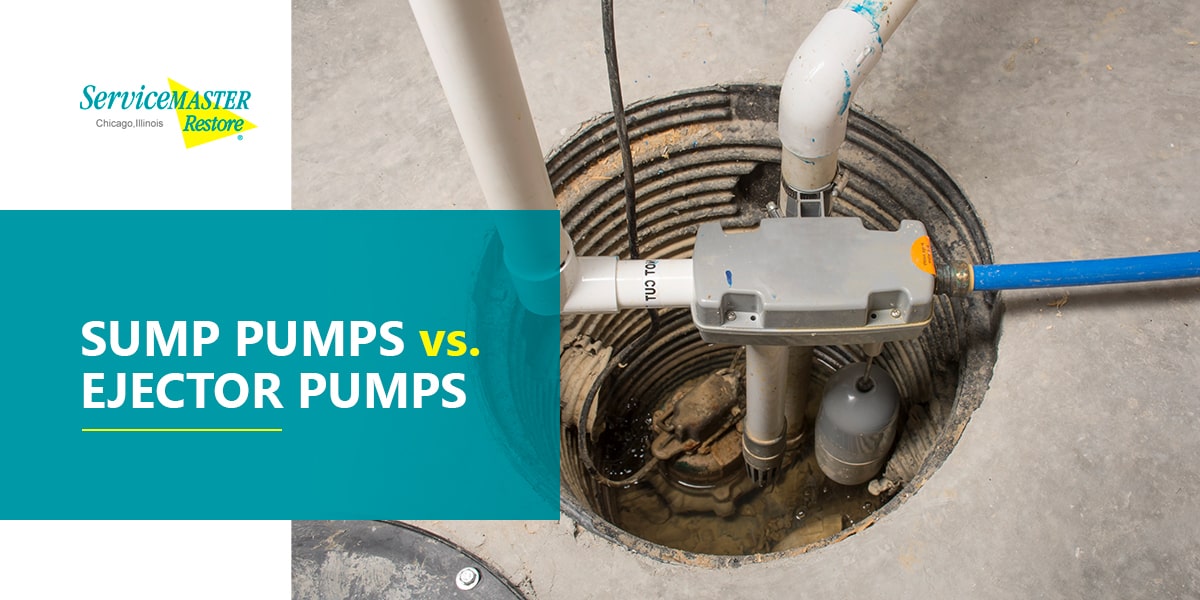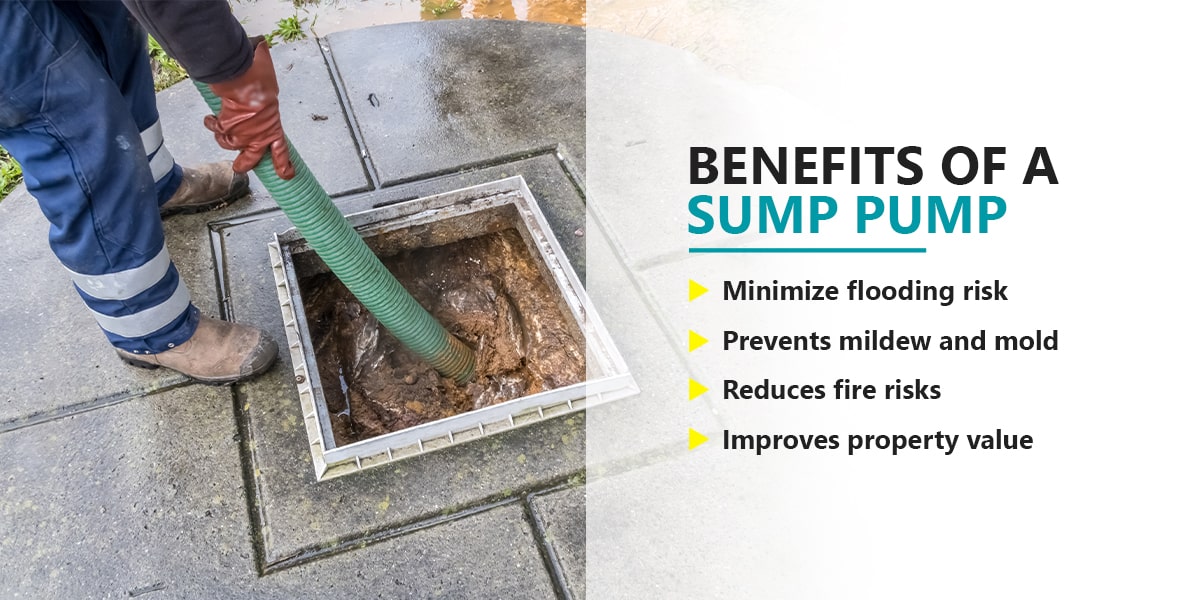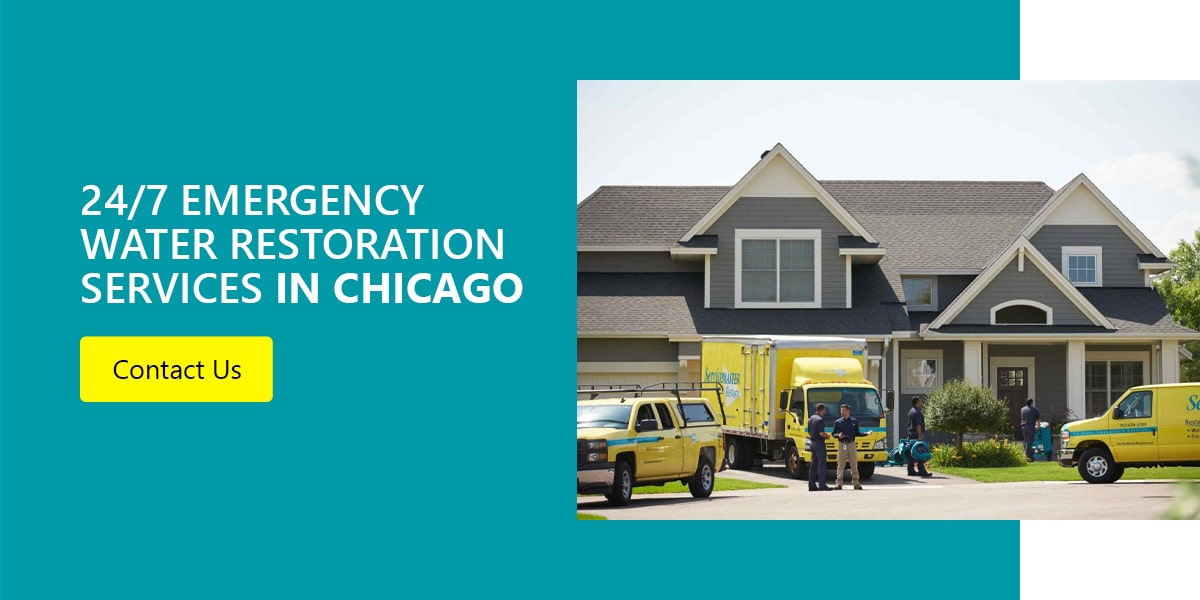
You may have heard of a sump pump and ejector pump. While these pumps may sound similar, they each perform a unique and valuable task to keep your home safe. Learn more about sump pumps and sewage ejector pumps and which is right for your home.
What Is a Sump Pump?
A sump pump is a submersible system placed in a sump pit at the lowest point in your house, often a crawlspace or basement. A sump pump is an essential system to help prevent excess moisture and flooding in your basement and home.
In most cases, a sump pump is on standby, waiting to activate if it is needed to remove excess water. If the ground around your home becomes oversaturated due to inclement weather, such as heavy rainfall or ice melting, the groundwater may funnel to your home.
Fortunately, a sump pit will begin to fill with water first, activating the sump pump float switch if the water reaches a certain level, turning the sump pump on. A sump pump can remove excess water and relocate the water to a nearby dry well, storm drain or detention pond.
An effective sump pump can prevent groundwater from rising to your crawlspace or basement floor, significantly reducing the risk of flooding. It redirects excess water through a discharge line, also known as an effluent line, which is connected to a designated drainage area. You can think of a sump pump as an added layer of flood prevention and security.

Benefits of a Sump Pump
Sump pumps are important devices that can remove water from your home to prevent water damage and flooding. Most sump pumps feature a float switch, which rises when the water level increases and triggers the sump pump’s motor to start removing water.
The lowest part of your home is often the first to flood or experience water damage, which can be extremely costly. Basement flooding can be expensive to repair and can also permanently damage your home and any prized possessions you may have in storage. Some of the main benefits of a sump pump include:
- Minimize flooding risk: One of the most obvious benefits of a sump pump is its ability to minimize flooding and excess moisture in your home. While a sump pump can effectively deal with gradual flooding, they are incredibly effective in dealing with quick or large-scale flooding. Even in heavy downpours, a sump pump can minimize the risk of flooding and can help keep your crawlspace and basement dry.
- Prevents mildew and mold: In addition to the immediate complications flooding can cause, high water levels and excess moisture also cause mold and mildew to develop. Mold and mildew can continue to damage walls, floors and any items you have stored in your basement, but they can also cause serious health complications. Keeping your basement dry can significantly reduce the risk of mildew growth.
- Reduces fire risks: While you may not initially think of a fire if your basement is flooding, excess water can be extremely dangerous and greatly increase the risk of electrical complications and fires. If your basement floods, it can short circuit any electronics, damaging these appliances and even leading to a potential house fire. Fortunately, a sump pump can minimize the risk of flooding and lower the risk of electrical fires.
- Improves property value: A sump pump can also increase property and home value. If you ever plan to sell your home, it can be an attractive advantage to potential buyers knowing a sump pump is installed. A sump pump can maintain the structural integrity of your home.
What Is an Ejector Pump?
An ejector pump, also known as a basement ejector pump, is similar to a sump pump in appearance and is also placed within a sump basin in a home’s basement. While a sump pump removes excess water, an ejector pump is used to remove sewage from the home. An ejector pump basin can collect sewage and water drains.
An ejector pump is connected to a dispersal device or storm drain to transfer sewage from the home. The debris is processed, and the ejector pump’s lid seals to minimize the risk of any harmful gases or chemicals entering the home.
In general, an ejector pump is often used in a home with a laundry room or bathroom in the basement. If the municipal sewer lines run to the street are elevated higher than the appliance, the ejector unit pumps solids and liquids into the sewer line, allowing for proper flow.
Ejector pumps are also common in septic drain-field systems, such as a location where a holding tank or septic drainage field is higher than the basement’s plumbing. An ejector pump is designed to sit within a sump basin, typically holding about 30 gallons of waste for a moderately sized home.
Benefits of an Ejector Pump
An ejector pump is an important aspect of your home’s plumbing system. Some of the main benefits of an ejector pump include:
- Ensure proper flow: When an ejector pump is installed to help your septic tank, it can keep the flow of waste and liquids moving evenly and consistently. An even flow to the tank is essential for ensuring waste materials continue moving to their intended location.
- Minimize waste buildup: An ejector pump can transfer waste reliably and quickly, helping your system prevent waste buildups, clogs and inefficiency. Minimizing waste buildup is also exceedingly important for materials flushed down your drains accidentally.
- Works efficiently: The most powerful sewage pumps can move up to 10,000 gallons of wastewater an hour. A slow-moving or inefficient system can cause clogs and lead to a less effective septic system.
- Promotes waste removal: If you have a bathroom or washing machine in your basement, you will need an ejector pump to work against gravity and ensure your waste materials can travel upwards and out into the septic tank. If gravity is working against any appliances below the septic system, you may want to consider an ejector pump.
Ejector Pump vs. Sump Pump
At first glance, an ejector pump and sump pump look quite similar, and these two systems are often installed next to one another. Despite these similarities, each pump performs a unique job and understanding the differences is important to maximize their benefits.
Because these systems look similar, the difference between sump pumps and ejector pumps is largely determined by their function. Simply put, a sump pump can prevent excess water from flooding a basement or crawlspace. Sump pumps are often vital in high-flood zones.
On the other hand, an ejector pump helps handle wastewater, including any sewage from appliances or bathrooms in your home’s basement. It is important to note rain and floodwater do not count as wastewater. A sump pump protects your home from water flowing in, while an ejector pump helps take water from inside your home’s plumbing out to the septic tank.
An ejector pump has a direct line to the sewer or septic tank, as well as a vent pipe to expel sewer fumes outside.
24/7 Emergency Water Restoration Services in Chicago
If you experience water damage or flooding in your home, you should contact a professional water removal and restoration specialist as quickly as possible. At ServiceMaster of Lincoln Park, we are dedicated to helping our customers find quick, reliable relief from water damage and flooding. Our highly trained water restoration professionals can help correct water damage and minimize long-term complications.
Contact our water restoration professionals today if you are dealing with water damage or flooding.


